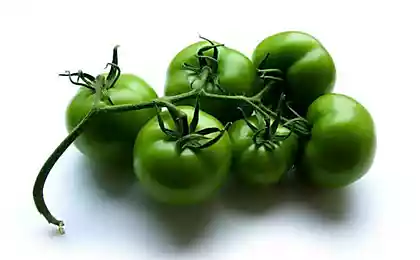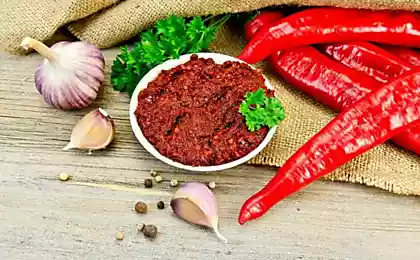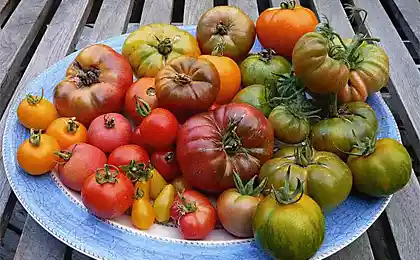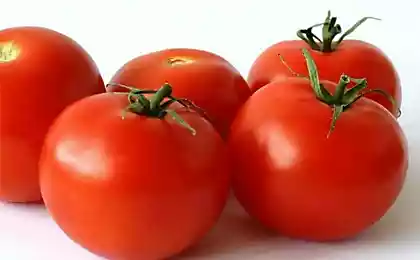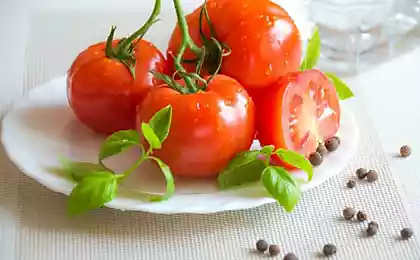590
Why leaves turn yellow tomatoes?
If you have a garden and you grow tomatoes there, you might have noticed that their leaves sometimes turn yellow. You could raise the question: "what do yellowing leaves of tomatoes?". It is known that they turn yellow for various reasons. This does not mean that the plant is gone. Scientific knowledge allows us to consider the causes of this very widespread phenomenon and understand what it should do and should somehow interfere with this. Modern science already allows to harvest tomatoes and potatoes from one Bush.

Causes of yellowing leaves tomato was considered Mirjevski Kathleen (Kathleen Mierzejewski) in the published resource Gardening Know How article "Learn More About What Causes Yellow Tomato Leaves".
If only a few yellowed leaves in the lower parts of the plant, the reason for the worries. The lower leaves of tomatoes turn yellow, as they probably do not get the nutrients from the soil and reaches the sunlight. This occurs most often when the plant matured and began to bear fruit.
This phenomenon there are other reasons which are not explained only by maturation. One of the reasons may be lack of nitrogen in the soil of your vegetable garden. In this case, you need to analyze the soil content of nitrogen or just add fertilizer and see stopped if the yellowing.
In addition, the cause of the yellowing leaves of tomatoes could be the infection of plants by fungus or bacteria. One of the most common although not the only disease of tomatoes is Alternaria alternata. In this case, it is necessary to hold appropriate treatment plants.
Sometimes yellow leaves on tomatoes mean defeat of plants by caterpillars and worms. In this case, it is preferable to treat the plants with organic pesticides.
But before considering other causes of yellowing leaves, you should make sure that the soil around the plants moist. The reason may be lack of watering tomatoes. Yellow leaves can only mean that the tomato is simply not enough water. Drip irrigation is an excellent approach to regularly moisten the soil and thus prevent yellowing leaves on tomato bushes.
Along with cucumbers, tomatoes are one of the most common summer vegetables. In agriculture cultivated hundreds of varieties of different shapes and sizes, including organic, hybrid and genetically modified. Most of the tomatoes when ripe become red, but there are also varieties with yellow, orange, pink, purple and white fruits. Resource Nutrition And You was considered useful qualities of tomatoes.
The benefits of tomatoes for health
Tomatoes are low in calories — they contain just 18 calories per 100 grams. They are characterized by low content of fat. In addition, tomatoes are an excellent source of antioxidants, dietary fiber, vitamins and minerals. Nutritionists often recommend them in programmes for control cholesterol and reduce weight.
Present in tomatoes antioxidants are considered to be scientists in the prevention of cancer, including cancers of the colon, prostate gland (prostate), breast, uterus, lung and pancreatic tumors. The total antioxidant ORAC index of tomatoes reflecting the absorption capacity of oxygen radicals, is 367 µmol TE per 100 grams.
Flavonoid antioxidant lycopene is unique to tomatoes phytochemical compound. Tomato varieties with red fruits tend to have higher levels of this antioxidant. Together with carotenoids, lycopene may help protect cells and other structures in the human body from harmful oxygen free radicals. Studies show that lycopene protects the skin from exposure to ultraviolet the best and thus provides some degree of prevention of skin cancer.
Zeaxanthin is another flavonoid compound, which is rich considering the vegetables. Zeaxanthin filter harmful ultraviolet rays, helps prevent age-related macular degeneration in older people.
In appreciable quantities tomatoes also contain vitamin A and flavonoid antioxidants such as beta-carotene, and lutein xanthine. It was found that these pigmenting compounds have antioxidant properties and play a role in ensuring the possibility for night vision, healthy skin, mucous membranes and bones. Consumption of flavonoid-rich natural vegetables and fruits is the prevention of lung cancer and oral cavity.
In addition, tomatoes are also a good source of antioxidant vitamin C. In 100 grams of tomato contains 21% of the daily consumption of this vitamin. Eating vitamin C rich foods promotes the production the body's resistance to infectious agents and cleanse it from harmful free radicals.
Fresh tomatoes are very rich in potassium. 100 grams of tomatoes contains 237 milligrams of potassium and only 5 milligrams of sodium. Potassium is an important component fluids of the cells and organism, helps control heart rate and blood pressure, increase sodium.
Tomatoes are characterized by a medium level content of B-complex vitamins, including folic acid, thiamin, Niacin, Riboflavin. Consider vegetables also contain a number of necessary for human body minerals — iron, calcium, manganese. In small quantities in tomatoes, there are other elements.
Caution
Allergic reactions to tomatoes are rare. While some sensitive people may experience symptoms such as itchy skin and eyes, runny nose and gastrointestinal disorder characterised by abdominal pain, vomiting and diarrhea.
The nutritional value of tomatoes
In parentheses are the percentage of the daily allowance. Nutritional value is based on 100 grams of tomatoes according to information from the Ministry of agriculture of the USA, shown in the resource Nutrition And You.
General information:
the energy value of — 18 kcal (1%);
carbohydrates and 3.9 grams (3%);
protein — 0.9 grams (1,6%);
fat — 0.2 grams (0,7%);
fiber, part of the food — 1.2 grams (3%).
Vitamins:
folic acid (vitamin B9) is 15 micrograms (4%);
nicotinic acid (vitamin B3) — 0,594 milligram (4%);
pyridoxine (vitamin B6) is 0.080 milligrams (6%);
thiamine (vitamin B1) — 0.037 milligram (3%);
vitamin a, which very much is contained in dandelion — 833 international units (IU, IU) — 28%;
vitamin C — 13 mg (21,5%);
vitamin E 0.54 mg (4%);
vitamin K, an incredibly rich source of which is sage — 7.9 micrograms (6,5%);
Electrolytes:
sodium 5 milligrams (>1%);
potassium — 237 mg (5%).
Minerals:
calcium — 10 mg (1%);
iron is 0.3 milligrams (4%);
magnesium 11 mg (3%);
manganese is 0.15 milligrams (of 6.5%);
phosphorus 24 milligrams (3%);
zinc 0.17 mg (1,5%).
Phytonutrients:
alpha-carotene (α-carotene) — 101 micrograms;
beta-carotene (ß-carotene), which is rich in carrots — 449 micrograms;
lutein-zeaxanthin — 123 micrograms;
lycopene — 2573 micrograms.published
P. S. And remember, only by changing their consumption — together we change the world! ©
Source: hi-news.ru

Causes of yellowing leaves tomato was considered Mirjevski Kathleen (Kathleen Mierzejewski) in the published resource Gardening Know How article "Learn More About What Causes Yellow Tomato Leaves".
If only a few yellowed leaves in the lower parts of the plant, the reason for the worries. The lower leaves of tomatoes turn yellow, as they probably do not get the nutrients from the soil and reaches the sunlight. This occurs most often when the plant matured and began to bear fruit.
This phenomenon there are other reasons which are not explained only by maturation. One of the reasons may be lack of nitrogen in the soil of your vegetable garden. In this case, you need to analyze the soil content of nitrogen or just add fertilizer and see stopped if the yellowing.
In addition, the cause of the yellowing leaves of tomatoes could be the infection of plants by fungus or bacteria. One of the most common although not the only disease of tomatoes is Alternaria alternata. In this case, it is necessary to hold appropriate treatment plants.
Sometimes yellow leaves on tomatoes mean defeat of plants by caterpillars and worms. In this case, it is preferable to treat the plants with organic pesticides.
But before considering other causes of yellowing leaves, you should make sure that the soil around the plants moist. The reason may be lack of watering tomatoes. Yellow leaves can only mean that the tomato is simply not enough water. Drip irrigation is an excellent approach to regularly moisten the soil and thus prevent yellowing leaves on tomato bushes.
Along with cucumbers, tomatoes are one of the most common summer vegetables. In agriculture cultivated hundreds of varieties of different shapes and sizes, including organic, hybrid and genetically modified. Most of the tomatoes when ripe become red, but there are also varieties with yellow, orange, pink, purple and white fruits. Resource Nutrition And You was considered useful qualities of tomatoes.
The benefits of tomatoes for health
Tomatoes are low in calories — they contain just 18 calories per 100 grams. They are characterized by low content of fat. In addition, tomatoes are an excellent source of antioxidants, dietary fiber, vitamins and minerals. Nutritionists often recommend them in programmes for control cholesterol and reduce weight.
Present in tomatoes antioxidants are considered to be scientists in the prevention of cancer, including cancers of the colon, prostate gland (prostate), breast, uterus, lung and pancreatic tumors. The total antioxidant ORAC index of tomatoes reflecting the absorption capacity of oxygen radicals, is 367 µmol TE per 100 grams.
Flavonoid antioxidant lycopene is unique to tomatoes phytochemical compound. Tomato varieties with red fruits tend to have higher levels of this antioxidant. Together with carotenoids, lycopene may help protect cells and other structures in the human body from harmful oxygen free radicals. Studies show that lycopene protects the skin from exposure to ultraviolet the best and thus provides some degree of prevention of skin cancer.
Zeaxanthin is another flavonoid compound, which is rich considering the vegetables. Zeaxanthin filter harmful ultraviolet rays, helps prevent age-related macular degeneration in older people.
In appreciable quantities tomatoes also contain vitamin A and flavonoid antioxidants such as beta-carotene, and lutein xanthine. It was found that these pigmenting compounds have antioxidant properties and play a role in ensuring the possibility for night vision, healthy skin, mucous membranes and bones. Consumption of flavonoid-rich natural vegetables and fruits is the prevention of lung cancer and oral cavity.
In addition, tomatoes are also a good source of antioxidant vitamin C. In 100 grams of tomato contains 21% of the daily consumption of this vitamin. Eating vitamin C rich foods promotes the production the body's resistance to infectious agents and cleanse it from harmful free radicals.
Fresh tomatoes are very rich in potassium. 100 grams of tomatoes contains 237 milligrams of potassium and only 5 milligrams of sodium. Potassium is an important component fluids of the cells and organism, helps control heart rate and blood pressure, increase sodium.
Tomatoes are characterized by a medium level content of B-complex vitamins, including folic acid, thiamin, Niacin, Riboflavin. Consider vegetables also contain a number of necessary for human body minerals — iron, calcium, manganese. In small quantities in tomatoes, there are other elements.
Caution
Allergic reactions to tomatoes are rare. While some sensitive people may experience symptoms such as itchy skin and eyes, runny nose and gastrointestinal disorder characterised by abdominal pain, vomiting and diarrhea.
The nutritional value of tomatoes
In parentheses are the percentage of the daily allowance. Nutritional value is based on 100 grams of tomatoes according to information from the Ministry of agriculture of the USA, shown in the resource Nutrition And You.
General information:
the energy value of — 18 kcal (1%);
carbohydrates and 3.9 grams (3%);
protein — 0.9 grams (1,6%);
fat — 0.2 grams (0,7%);
fiber, part of the food — 1.2 grams (3%).
Vitamins:
folic acid (vitamin B9) is 15 micrograms (4%);
nicotinic acid (vitamin B3) — 0,594 milligram (4%);
pyridoxine (vitamin B6) is 0.080 milligrams (6%);
thiamine (vitamin B1) — 0.037 milligram (3%);
vitamin a, which very much is contained in dandelion — 833 international units (IU, IU) — 28%;
vitamin C — 13 mg (21,5%);
vitamin E 0.54 mg (4%);
vitamin K, an incredibly rich source of which is sage — 7.9 micrograms (6,5%);
Electrolytes:
sodium 5 milligrams (>1%);
potassium — 237 mg (5%).
Minerals:
calcium — 10 mg (1%);
iron is 0.3 milligrams (4%);
magnesium 11 mg (3%);
manganese is 0.15 milligrams (of 6.5%);
phosphorus 24 milligrams (3%);
zinc 0.17 mg (1,5%).
Phytonutrients:
alpha-carotene (α-carotene) — 101 micrograms;
beta-carotene (ß-carotene), which is rich in carrots — 449 micrograms;
lutein-zeaxanthin — 123 micrograms;
lycopene — 2573 micrograms.published
P. S. And remember, only by changing their consumption — together we change the world! ©
Source: hi-news.ru
Innovative system for cleaning the ocean from plastic will be launched in 2016 (+Video)
Light Phone - phone the size of a credit card c
